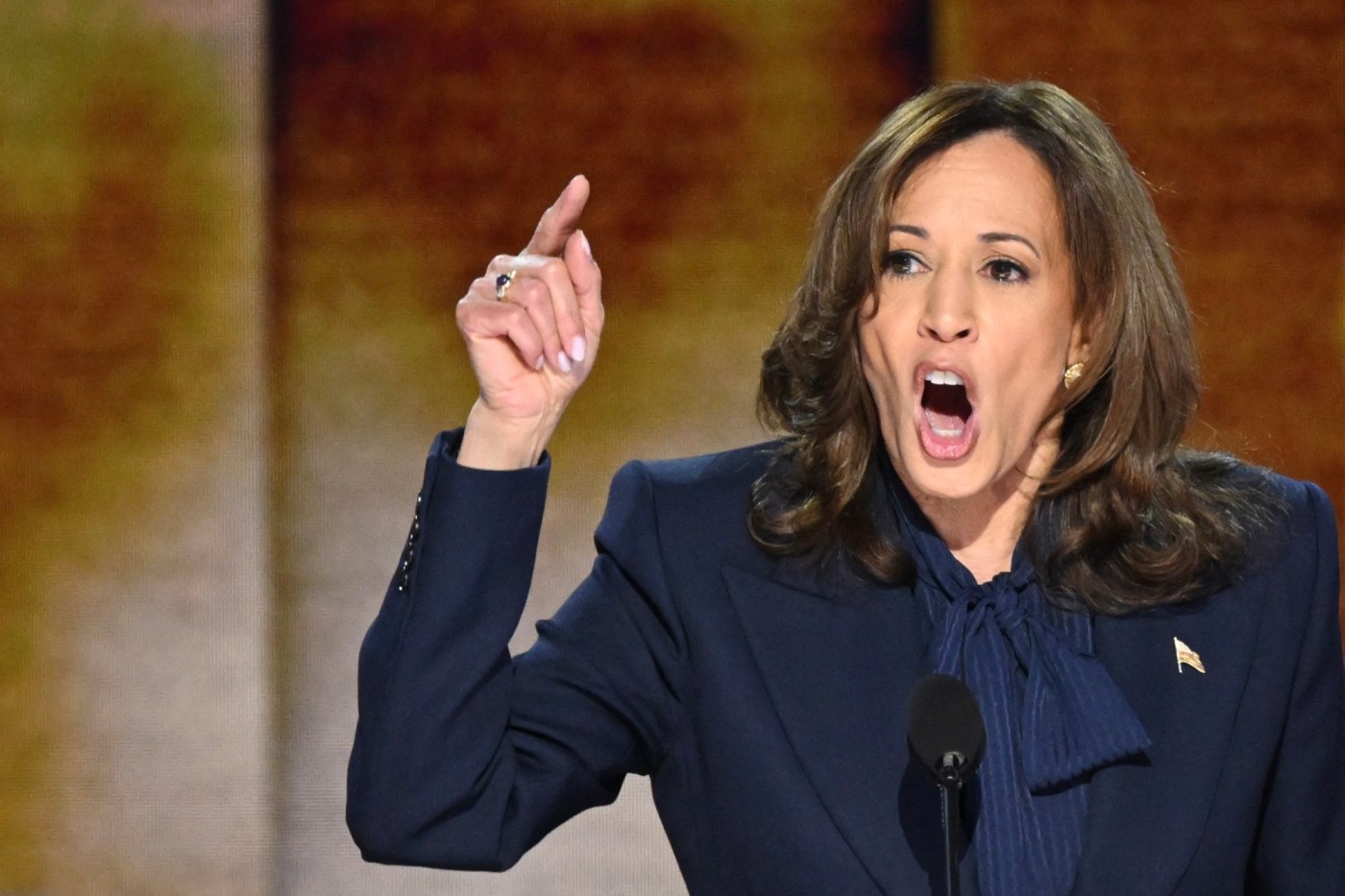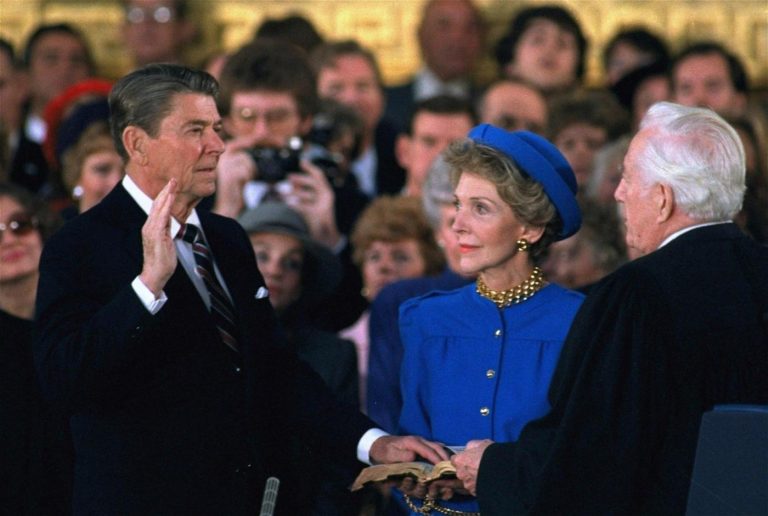Robert Farley, Eugene Kiely, Jessica McDonald, Lori Robertson, D’Angelo Gore, Alan Jaffe and Kate Yandell | (TNS) CQ-Roll Call
CHICAGO — The Democratic convention wrapped up with Vice President Kamala Harris’ speech accepting the party’s nomination for president. She made some misleading or unsupported claims about her opponent, including several FactCheck.org has heard this week.
Harris claimed former President Donald Trump “intends to enact what in effect is a national sales tax” that would “raise prices on middle-class families by almost $4,000 a year.” That’s a speculative estimate from a liberal think tank based on the upper-end of a Trump-proposed tariff on imported goods. And it ignores other Trump proposals that might lower middle-income taxes.
Harris misleadingly claimed that Trump will give billionaires “another round of tax breaks that will add up to $5 trillion to the national debt.” That’s the estimated 10-year cost of extending all the tax cuts in Trump’s 2017 tax law, but those tax changes benefited people of all income groups.
In warning about the dangers of a Trump presidency, Harris said the U.S. Supreme Court “ruled that he would be immune from criminal prosecution.” The ruling said a president is entitled to a “presumption of immunity” for “official acts,” but not for “unofficial acts” and “not everything the President does is official.”
She said part of Trump’s “agenda” is to “limit access to birth control.” Project 2025, a conservative plan published by the Heritage Foundation, calls for ending mandatory health insurance coverage of emergency contraception, but Trump has said he opposes placing limits on birth control.
Harris said Trump and his allies would “ban medication abortion and enact a nationwide abortion ban, with or without Congress.” However, Trump has said this year that he would not sign a national abortion ban and has suggested he would maintain the status quo on medication abortion.
The vice president claimed Trump plans to “force states to report on women’s miscarriages and abortions.” Project 2025 proposes making such reporting mandatory, but Trump has said it should be up to individual states.
Harris and other speakers said Trump “encouraged Putin to invade” a NATO country. In context, Trump said he told a NATO member that he “would encourage them [Russia] to do whatever the hell they want” unless the country dedicated more money to defense spending.
Continuing a theme for the week, Sen. Tammy Baldwin of Wisconsin made the unsupported claim that Trump would cut Social Security and Medicare, pointing to a quote that his campaign says referred to cutting waste and fraud, not benefits.
Harris also misleadingly claimed that Trump had “tried to cut Social Security and Medicare.” Trump’s budgets when he was president didn’t propose cuts to Social Security’s retirement benefits, and they included bipartisan proposals to reduce the growth of Medicare without cutting benefits. He did propose cuts for Social Security disability and supplemental income programs.
Impact of Trump’s tariffs
Harris claimed that Trump “intends to enact what in effect is a national sales tax, call it a Trump tax, that would raise prices on middle-class families by almost $4,000 a year.”
She’s referring to Trump’s plan to impose “universal baseline tariffs” on foreign imports. Whether it will cost middle-income families that much is speculative, in part because Trump has been inconsistent and opaque about what exactly he is proposing.
The estimate cited by Harris comes from a liberal think tank, the Center for American Progress Action Fund, based on a 20 percent across-the-board import tax combined with a 60 percent tariff on Chinese goods. The group concluded such tariffs would amount to “a $3,900 tax increase for a middle-income family” annually.
Since announcing in February 2023 his proposal for ”universal baseline tariffs on most foreign products,” Trump has most often talked about setting those baseline tariffs at 10 percent, as he did in an Aug. 18, 2023, interview on Fox News. “I think we should have a ring around the collar, as they say,” Trump said, later adding, “I do like the 10 percent for everybody.”
But he hasn’t been definitive about that. In an April interview with Time, Trump was asked if that blanket 10 percent tariff was his plan. He responded, “It may be more than that. It may be a derivative of that.”
At a recent rally in North Carolina on Aug. 14, Trump increased the potential upper-end of the blanket tariff, saying, “We are going to have 10 to 20 percent tariffs on foreign countries that have been ripping us off for years.”
That prompted the Center for American Progress Action Fund estimate of $3,900, which is based on 20 percent. Based on Trump’s initial 10 percent tariff suggestion, the group had previously put the cost to “a typical family” at $2,500 per year.
Other nonpartisan groups have come in with lower estimates. Based on a 10 percent worldwide tariff and a 60 percent tax on imported Chinese goods, the Tax Policy Center estimated a more modest $1,350 cost to middle-income households. Using those same parameters, an analysis from the Peterson Institute for International Economics concluded Trump’s proposed tariffs would cost a typical middle-income household about $1,700 in increased expenses each year. The Tax Foundation estimates such tariffs would decrease the incomes of those in the middle by 1.5 percent.
So at best, the figure Harris cited is an upper-end estimate that assumes Trump would enact a 20 percent tariff on all imported goods (which, in fairness, he has at least floated as an upper-end possibility).
Further muddying Harris’ claim is that Trump has proposed other tax plans that would benefit some middle-income families, such as eliminating taxes on Social Security and tips. According to a Tax Policy Center analysis, eliminating taxes on Social Security benefits would result in an average tax cut of about $630 for about 28 percent of middle-income families. TPC has not modeled Trump’s tips idea “but the vast majority of middle-income households would not benefit, either because they have no tip compensation or because they get tips but still make too little to pay income tax, even under current law. Trump won’t say if he’d also exempt payroll taxes,” Howard Gleckman, a senior fellow at the Tax Policy Center, told us via email.
Trump has also proposed to extend the expiring individual tax cut provisions contained in the Tax Cuts and Jobs Act that he championed in 2017. Gleckman said TPC estimated middle-income households would get an average tax cut of about $1,000 from such an extension.
So how would the sum of Trump’s proposals affect middle-income families?
“It is impossible to know since Trump has proposed many different, and often inconsistent, proposals,” Gleckman told FactCheck.org via email. “And he’s left out important details for many proposals.”
“Most middle-income households probably would be worse off with a 20 percent worldwide tariff, if the CAP estimate is right,” Gleckman told FactCheck.org. “At a 10 percent rate, nearly everyone in the middle-income group would be somewhat worse off, even with those other tax cuts. But a middle-income household that now pays tax on Social Security benefits and is paid enough in tips might be close to break-even with a 10 percent tariff.”
Erica York, senior economist and research director with the Tax Foundation’s Center for Federal Tax Policy, told FactCheck.org via email that it is difficult to evaluate the full impact of Trump’s tax plans because he has haphazardly “tossed out several different tax policy ideas.”
“The ultimate effect on people’s incomes depends on how much of the tariff agenda is fully implemented compared to the tax cuts,” York said. “If tariffs are fully pursued, low- and middle-income taxpayers are likely to see tax increases on net, while upper income taxpayers are likely to still come out ahead.”
For his part, Trump insists — contrary to most economists — that tariffs would not affect Americans’ bottom line.
“A tariff is a tax on a foreign country,” Trump said at a rally in Pennsylvania on Aug. 17. “That’s the way it is, whether you like it or not. A lot of people like to say, ‘Oh, it’s a tax on us.’ No, no, no. It’s a tax on a foreign country. … It’s a tax that doesn’t affect our country.”
Earlier this year, York told FactCheck.org that, to the contrary, “When the U.S. imposes a tariff, the person in the United States who is importing the good pays a tax to the U.S. government when they import the foreign goods. U.S. tariffs are taxes on U.S. consumers of foreign goods that must be paid by the importer of the good.”
Asked for comment about the specifics of what Trump is proposing and whether it would impact middle-income families, Karoline Leavitt, a spokesperson for the Trump campaign, told FactCheck.org via email: “President Trump successfully imposed tariffs on China in his first term AND cut taxes for hardworking Americans here at home – and he will do it again in his second term.”
Tax cuts
Harris made the misleading claim that Trump intends to reward billionaires with more tax cuts instead of looking out for the middle class.
“I think everyone here knows he doesn’t actually fight for the middle class,” she said of Trump. “Instead, he fights for himself and his billionaire friends, and he will give them another round of tax breaks that will add up to $5 trillion to the national debt.”
As FactCheck.org has written, the vice president is referring to a 10-year cost estimate of extending all the income and corporate tax cuts included in the Tax Cuts and Jobs Act, which Trump signed in December 2017. If Congress does not act, many of the tax cuts, including the individual income tax cuts, will expire after 2025. Trump has proposed keeping them.
But extending the tax cuts would not just benefit Trump and other billionaires, as Harris suggested.
Howard Gleckman, a senior fellow at the Tax Policy Center, wrote in a July 8 blog item that it would cost an estimated $4 trillion over 10 years to extend the TCJA’s expiring tax cut provisions. If that happens, less than half — about 45 percent — of the tax cut benefits would go to taxpayers earning $450,000 or more, Gleckman said.
Also, President Joe Biden has advocated extending some of the tax cuts — the provisions for individual filers earning less than $400,000 and married couples making less than $450,000. Harris has not yet provided a detailed tax plan.
Trump with ‘no guardrails’
As Harris alluded to in her speech, Trump has repeatedly threatened during the course of the 2024 campaign to investigate and jail journalists and political opponents, and he has said he would consider pardoning everyone convicted for their actions during the Jan. 6, 2021, attack on the U.S. Capitol.
She then warned what a Trump presidency might mean after a recent U.S. Supreme Court decision on the issue of presidential immunity.
“Consider the power he will have, especially after the United States Supreme Court just ruled that he would be immune from criminal prosecution,” Harris said. “Just imagine Donald Trump with no guardrails, and how he would use the immense powers of the presidency of the United States.”
The high court did not give the president total immunity from criminal prosecution, as Harris’ remarks suggested.
The U.S. Supreme Court ruled on July 1 that a president should enjoy a “presumption of immunity” when carrying out “official acts.” However, Chief Justice John Roberts wrote in the court’s 6-3 ruling that “[t]he President enjoys no immunity for his unofficial acts, and not everything the President does is official.”
The decision was issued after Trump moved to dismiss a federal indictment that accused him of conspiring to overturn the 2020 election results. Trump claimed a president enjoys “absolute immunity” from criminal prosecution, but the Supreme Court didn’t go quite that far. The court returned the case to the trial court with instructions to consider Trump’s specific actions cited in the criminal indictment.
For example, the ruling said Trump is “absolutely immune from prosecution for the alleged conduct involving his discussions with Justice Department officials.” The lawsuit alleges that Trump and his unnamed co-conspirators pressured Justice officials to lie to state officials in seven states that Trump lost and tell them that “the Justice Department had identified significant concerns” about the election results. By doing so, Trump hoped to then convince lawmakers in those states to replace “legitimate” Biden electors with “fraudulent” Trump electors, the indictment said.
The high court further instructed the trial court that in “dividing official from unofficial conduct, courts may not inquire into the President’s motives.”
In her dissent, Justice Sonia Sotomayor expressed “fear for our democracy,” writing that “a President’s use of any official power for any purpose, even the most corrupt, is immune from prosecution.”
Project 2025 and birth control
After speaking about how Trump was proud of appointing conservative judges who overturned Roe v. Wade, the 1973 decision establishing a constitutional right to abortion, Harris made a variety of claims about Trump’s plans to put restrictions on women’s health.
“And understand he is not done,” she said. “As a part of his agenda, he and his allies would limit access to birth control, ban medication abortion, and enact a nationwide abortion ban, with or without Congress.”
This is a reference to Project 2025, a 900-page plan for a Republican presidency published by the Heritage Foundation, a conservative think tank.
Earlier in her speech, Harris also tied Trump to the document. “We know what a second Trump term would look like,” she said. “It’s all laid out in Project 2025, written by his closest advisors, and its sum total is to pull our country back to the past.”
Trump, however, did not have a role in crafting the document, and Project 2025 doesn’t serve as the official Republican platform.
In April 2022, Trump seemed to allude to the effort, calling the Heritage Foundation “a great group” that is “going to lay the groundwork and detail plans for exactly what our movement will do.” A CNN review identified at least 140 people who worked in the Trump administration who participated in the project, including six former Cabinet secretaries.
But Trump has since distanced himself from Project 2025, saying he knows “nothing” about it and that he hasn’t even “seen” it. He has vaguely said that he agrees with some of it and disagrees with other parts.
On several key issues, though, Trump’s stance differs from what’s stated in the document. That includes birth control.
As FactCheck.org explained Wednesday, when Colorado Gov. Jared Polis made a similar claim about contraception, Project 2025 calls for a health insurance coverage change that could limit access to a particular emergency contraceptive, but it does not target typical birth control methods more broadly.
The document specifically proposes ending mandatory health insurance coverage of Ella, an emergency contraceptive that can be taken up to five days after sexual intercourse. Under the Affordable Care Act, health insurance plans must cover the drug, like other contraceptives and preventive care, at no cost to the patient. The document also calls for the defunding of Planned Parenthood, which could indirectly make it more difficult for many to obtain birth control.
But again, Trump has said he opposes placing limits on birth control.
Abortion
Harris also said that “as a part of his agenda,” Trump and his allies would “ban medication abortion and enact a nationwide abortion ban, with or without Congress.” Other Democrats made similar claims on prior nights of the convention.
But Trump recently has expressed support for the status quo when it comes to medication abortion. He also has said he is no longer in favor of a nationwide abortion ban, preferring to leave the issue up to the states.
During his first campaign for president and in his presidency, Trump said he would support a federal ban on abortion past 20 weeks in most cases. But this year, he has said he would not sign a federal abortion ban. “The states will determine by vote or legislation or perhaps both, and whatever they decide must be the law of the land,” he said on Truth Social in April.
Trump also has recently expressed a desire to defer to the Supreme Court on medication abortion. “Well, it’s going to be available, and it is now,” he told CBS News on Aug. 19, in response to a question about whether medication abortion drugs should be available. “And as I know it, the Supreme Court has said, ‘Keep it going the way it is.’ I will enforce and agree with the Supreme Court.” (In the case in question, the high court said the plaintiffs didn’t have standing, but it didn’t rule on the merits of the challenge to the Food and Drug Administration’s approval of one of the drugs used in medication abortions.)
Project 2025 has endorsed further efforts to curtail abortion access nationwide. As FactCheck.org has previously written, the manual suggests that the Department of Justice should enforce an 1873 anti-vice law, called the Comstock Act, to prevent abortion pills from being sent through the mail. Experts have suggested the act could be used to prevent the shipment of all abortion-related materials.
In the same Aug. 19 CBS News interview, Trump said he would not enforce the Comstock Act “generally,” while saying “we will be discussing specifics of it.”
Project 2025 also contains further-reaching suggestions that the next conservative president should attempt to limit abortion nationwide, calling the decision to strike down Roe v. Wade “just the beginning.” The president “should work with Congress to enact the most robust protections for the unborn that Congress will support while deploying existing federal powers to protect innocent life and vigorously complying with statutory bans on the federal funding of abortion,” the document says.
As FactCheck.org said, Trump has attempted to distance himself from Project 2025, saying he disagrees with some parts and agrees with others.
Miscarriage and abortion monitoring
As an extension of the things Trump “and his allies” would do, Harris claimed Trump “plans to create a national anti-abortion coordinator and force states to report on women’s miscarriages and abortions.”
Trump himself has not proposed this, but some of it matches what is detailed in Project 2025.
In a section dedicated to the Centers for Disease Control and Prevention, Project 2025 notes that states voluntarily report abortion data and calls for the improved reporting of those statistics, including through legislation that requires “states, as a condition of federal Medicaid payments for family planning services, to report streamlined variables in a timely manner.”
“HHS should use every available tool, including the cutting of funds, to ensure that every state reports exactly how many abortions take place within its borders, at what gestational age of the child, for what reason, the mother’s state of residence, and by what method,” the document reads, referring to the Department of Health and Human Services. “It should also ensure that statistics are separated by category: spontaneous miscarriage; treatments that incidentally result in the death of a child (such as chemotherapy); stillbirths; and induced abortion.”
“Miscarriage management or standard ectopic pregnancy treatments should never be conflated with abortion,” it adds.
Project 2025 does not include mention of a “national anti-abortion coordinator.” FactCheck.org asked the Harris campaign about this, but they did not immediately respond.
The document does list an “unapologetically pro-life politically appointed Senior Coordinator of the Office of Women, Children, and Families,” but that proposed position falls under the government’s international development agency. It doesn’t appear to have anything to do with domestic abortion data collection.
In an interview with Time in April, Trump was asked whether he thought states that had banned abortion “should monitor women’s pregnancies so they can know if they’ve gotten an abortion after the ban.” Trump responded, “I think they might do that,” but said that would be left to “the individual states,” just as he says abortion laws should be determined by each state.
Biden has subsequently twisted Trump’s words to claim Trump said states “should” monitor women’s pregnancies, as FactCheck.org has written.
Trump’s ‘Whatever the hell they want’ comments
In her remarks on international relations, Harris said she would ensure that the U.S. will “not abdicate our global leadership.” She continued: “Trump, on the other hand, threatened to abandon NATO. He encouraged Putin to invade our allies, said Russia could, quote, ‘do whatever the hell they want.’”
Earlier in the evening, Sen. Mark Kelly of Arizona made a similar comment. Kelly said, “Today, Vladimir Putin is testing whether we’re still that strong. Iran, North Korea and especially China watch closely. What’s Trump’s answer? He invited Russia to do, and these are his words, not mine, ‘whatever the hell they want.’” Following Kelly, former Secretary of Defense Leon Panetta, said: “Trump tells tyrants like Putin, they can do whatever the hell they want.”
But the Democrats omit the context of Trump’s statement and whom he says he was addressing when he made the comment.
At a campaign rally in South Carolina in February, Trump said that when he was president he had told a leader of a NATO member nation that the European partners had to dedicate more money to defense spending. He said that if the country was “delinquent” in its payments to NATO and Russia attacked it, “I would not protect you.”
“‘You didn’t pay? You’re delinquent?’” Trump said he told the unidentified NATO partner. “‘No I would not protect you. In fact, I would encourage them to do whatever the hell they want. You gotta pay. You gotta pay your bills.’”
So Trump wasn’t addressing Putin directly — though the Russian president likely is aware of Trump’s public remarks. Trump said he was pressuring a NATO member to direct more support to its defense budget.
As FactCheck.org wrote after Trump made those comments, he has long mischaracterized what he calls “delinquent” payments from alliance members to NATO.
Social Security/Mediscare, again
For the fourth night in a row, Democrats made the unsupported claim that Trump would cut Social Security and Medicare — a political talking point regularly seen in presidential races and have referred to as “Mediscare.” Sen. Tammy Baldwin of Wisconsin kicked it off within the first hour of the evening program, claiming: “Donald Trump was asked what he would do about Social Security and Medicare and he said and I quote, ‘There’s a lot you can do in terms of cutting.’ Cutting? He’s talking about cutting Social Security and Medicare, while giving a huge new tax break to billionaires and corporations?”
But Trump has promised not to cut Medicare or the Social Security retirement program, and his campaign says the quote Baldwin cited referred to cutting waste and fraud.
In a March 11 interview with CNBC, Trump was asked how he would address the rising costs of both programs. Trump said: “So first of all, there is a lot you can do in terms of entitlements in terms of cutting and in terms of also the theft and the bad management of entitlements, tremendous bad management of entitlements.”
Again, the Trump campaign said he was referring to cutting waste and fraud in those programs – and there is evidence to support the idea that Trump wasn’t talking about cutting benefits, as Baldwin and other Democrats suggest.
Harris made a similar claim in her speech, misleadingly saying, “We are not going back to when Donald Trump tried to cut Social Security and Medicare.” As FactCheck.org has written before, Trump’s budgets when he was president didn’t propose cuts to Social Security’s retirement benefits, although his budgets did propose cutting the Social Security Disability Insurance and Supplemental Security Income programs.
His budgets also included bipartisan proposals to reduce the growth of Medicare without cutting benefits. The watchdog group Committee for a Responsible Federal Budget said the Medicare proposals in Trump’s 2021 budget proposal, which were similar to those in the 2020 budget, “represent reductions in costs not cuts to benefits.”
As a candidate in this election, Trump hasn’t released any detailed proposal to cut either program. However, his plan to eliminate taxes on Social Security income for seniors could result in reduced Social Security and Medicare benefits in the next decade, unless Trump provides a plan to replace the revenues that both programs would lose under his no-tax plan. Otherwise, a future Congress and president would have to replace the lost funds.
As for Baldwin’s claim that Trump would give “a huge new tax break to billionaires and corporations,” most of the tax cuts Trump has proposed would benefit taxpayers at all income levels. Most notably, Trump plans to extend the individual tax cuts in the 2017 tax law, as FactCheck.org said. A Tax Policy Center distributional analysis found that for middle-income households, about 86 percent would pay less in taxes and 13 percent would pay more in 2027 if those tax provisions are extended.
___
©2024 CQ-Roll Call, Inc., All Rights Reserved. Visit cqrollcall.com. Distributed by Tribune Content Agency, LLC.












